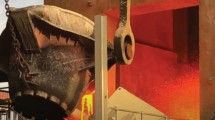Abstract
Understanding and reducing air entrainment in liquid metals is important for improving casting filling systems and liquid metal transfer processes. Air entrainment generates oxide inclusions that reduce the mechanical performance of metals. This paper presents air entrainment measurements for a jet of liquid aluminum alloy A356 plunging into a pool. Measurements are performed in argon and air atmospheres and for a range of jet fall heights. The volume ratio of entrained gas to liquid aluminum poured is measured to be equal to 0.43 for an average jet impact velocity of about 3.8 m/s in the argon atmosphere. This ratio is of a similar magnitude as for water under the same jet parameters. For the corresponding experiment in air, the measured volumetric ratio is only 0.16. It is found that nearly 50 pct of the volume of oxygen entrained is consumed by oxidation, but this alone does not account for the difference between the measurements in inert and oxidizing atmospheres. Instead, the ratio for air is so low because during some portion of the experiment no air was entrained. The onset velocity for gas entrainment for a plunging jet of liquid A356 is found to be 3.9 m/s in an air atmosphere and 3.4 m/s in argon, with the difference attributed to the stabilizing effect of the oxide film on the jet surface in air. These are about three times greater than the onset velocity previously measured for water.










Similar content being viewed by others
References
H. Chanson: Hydraulics of Dams and River Structures, 2004, London, England, pp. 3–15.
[2] H. Chanson: Journal of Hydraulic Research, 2013, vol. 51(3), pp. 223-43.
[3] D. A. Ervine, E. McKeogh, and E. M. Elsawy: Proceedings of the Institution of Civil Engineers, 1980, vol. 69(2), pp. 425-45.
[4] K. J. Sene: Chem. Engineering Science, 1998, vol. 43, pp. 2615–23.
D.A. Ervine and A.A. Ahmed: Paper E1, International Conference on Hydraulic Modeling of Civil Engineering Structures, Coventry, England, 1982.
T. Brattberg and H. Chanson: Chem. Engineering Science, 1998, vol. 53(24), pp. 4113-27.
E. Sande and J. M. Smith: Chem. Eng. Sci., vol. 31, pp. 219-24 (1976).
A. K. Biń: Chem. Engineering Science, 1993, vol. 48, pp. 3585-30.
C. Wanstall, J. Griffin, and C.E. Bates: Paper No. 1.1, Proceedings of the 47th Steel Founders’ Society of America (SFSA) Technical and Operating Conference, Chicago, IL, 1993.
C.E. Bates and J. Griffin: Research Report No. 106, SFSA Crystal Lake, IL, 1994.
[11] J. Ciborowski and A. Bin: Int. Chem. (Polish), 1972, vol. 2, pp. 453-69.
[12] R. Gopalan and N. K. Prabhu: Material Science and Technology, 2011, vol. 27(12), pp. 1757-69.
[13] J. Campbell: Complete Casting Handbook: Metal Casting Processes, Techniques and Design, Elsevier Science & Technology, Oxford, UK, 2011, pp. 19-77.
JMatPro, Sente Software Ltd, Surrey Technology Center, Surrey GU2 7YG, United Kingdom.
ASME Test Uncertainty, PTC 19.1-2005, American Society of Mechanical Engineering, New York, NY.
MAGMAsoft, MAGMA Gmbh, Kackerstrasse 11, 52072 Aachen, Germany.
[17] T. Campbell, R. K. Kalia, A. Nakano, and P. Vashishta: Physical Review Letters, 1999 vol. 82(24), pp. 4866-69.
[18] J. P. Anson, R. A. L. Drew, and J. E. Gruzleski: Metallurgical and Materials Transactions B, 1999, vol. 30(6), pp. 1027-32.
[19] N. B. Vargaftik, B. N. Volkov, and L. D. Voljak: Journal of Physical and Chemical Reference Data, 1983 vol. 12(3), pp. 817-20.
Acknowledgments
The authors wish to thank David Weiss, Dan Hoefert, and the rest of the team at Eck Industries for providing the use of their foundry and support during the aluminum experiments. F.V. Guerra acknowledges CONACYT for the scholarship provided to him during his postdoctoral work at the University of Iowa and the Metallurgical and Materials Research Institute of the Universidad Michoacana de San Nicolás de Hidalgo for supporting the application. This American Metalcasting Consortium (AMC) project is sponsored by the Defense Logistics Agency Troop Support, Philadelphia, PA and the Defense Logistics Agency Information Operations, J68, Research & Development, Ft. Belvoir, VA.
Author information
Authors and Affiliations
Corresponding author
Additional information
Publisher's Note
Springer Nature remains neutral with regard to jurisdictional claims in published maps and institutional affiliations.
Manuscript submitted June 2, 2020; accepted October 2, 2020.
Rights and permissions
About this article
Cite this article
Guerra, F.V., Archer, L., Hardin, R.A. et al. Measurement of Air Entrainment During Pouring of an Aluminum Alloy. Metall Mater Trans B 52, 123–137 (2021). https://doi.org/10.1007/s11663-020-01998-3
Received:
Accepted:
Published:
Issue Date:
DOI: https://doi.org/10.1007/s11663-020-01998-3




